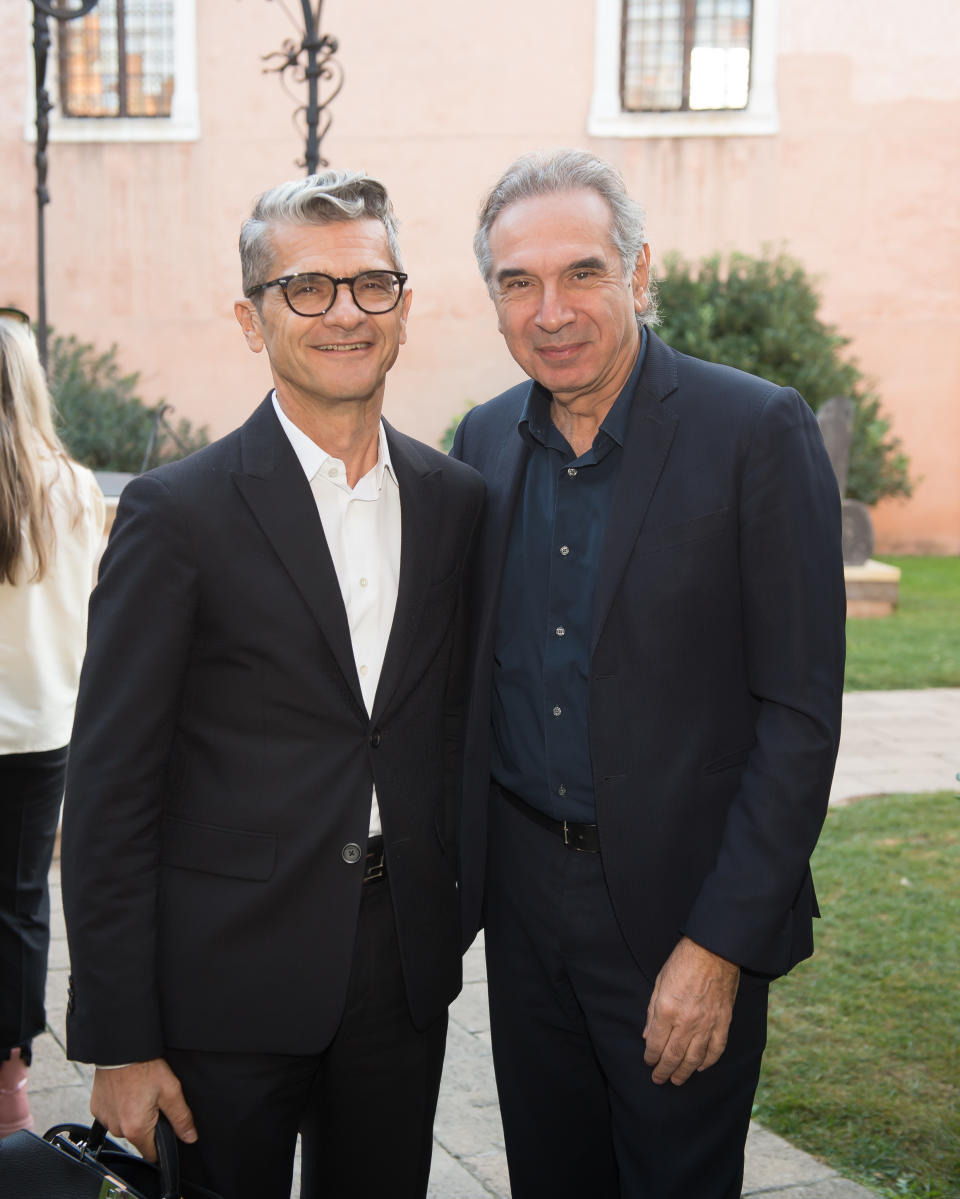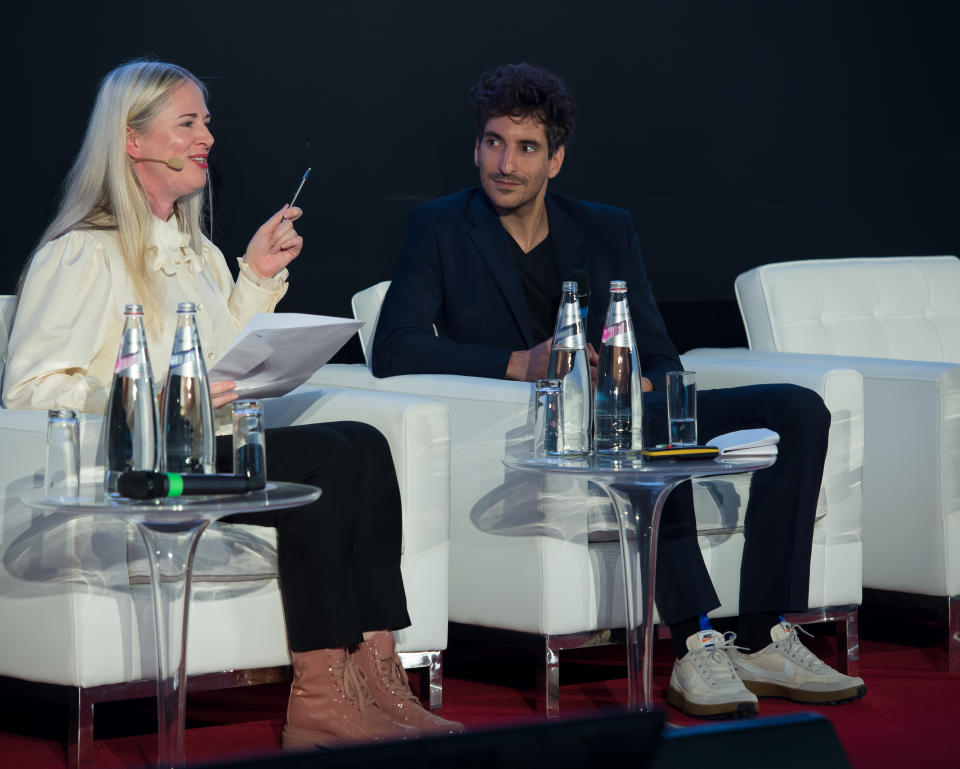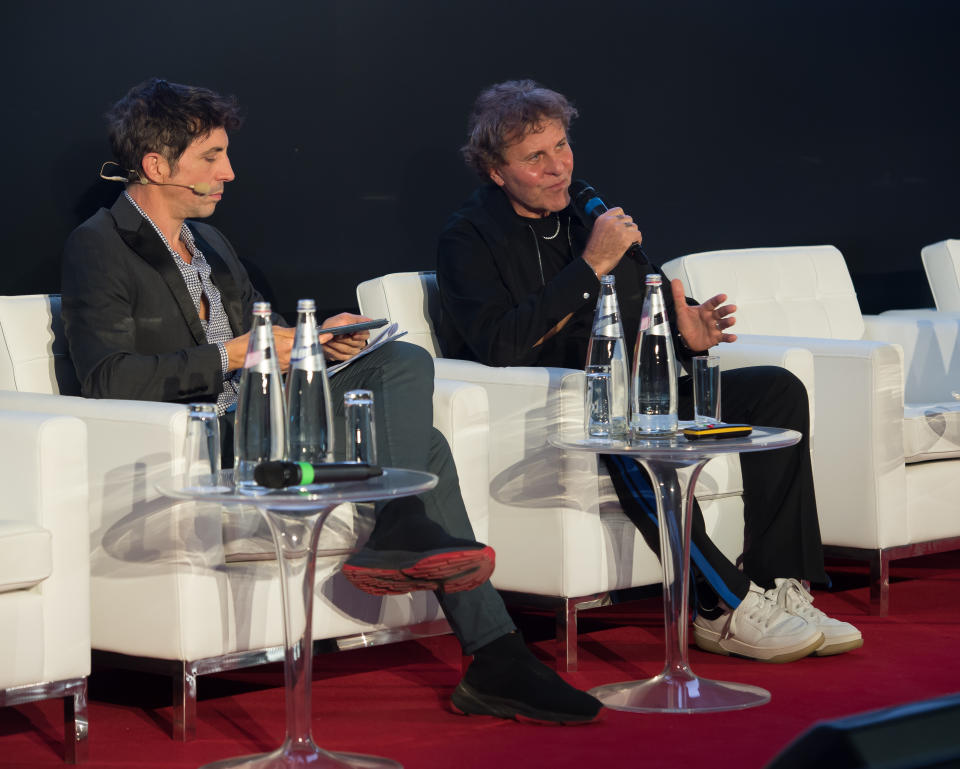
VENICE, Italy — Sustainability in fashion has made leaps in recent years but it has a long way to go as its complexity and many aspects pose daily challenges, regulatory nightmares and costs the supply chain as a whole has yet to account for.
“Sustainability is boring, burdensome and expensive,” said Claudio Marenzi, chairman and chief executive officer of Herno, summing up the challenges with a chuckle.
More from WWD
He was speaking at the seminal two-day Venice Sustainable Fashion Forum, which closed Friday and was organized by, among others, Camera Nazionale della Moda Italiana, Sistema Moda Italia and Confindustria Venezia to discuss where the eco-transition in the sector is headed.
The newly appointed minister for businesses and made in Italy Adolfo Urso addressed the forum in one of his first public speeches. “There’s more to add to made in Italy, in addition to the beautiful and well-made notions that are globally recognized by consumers. A technological element and sustainable developments should add a new layer of excellence,” he said.
Overcoming the hurdles of an eco-transition requires the efforts of brands and retailers, policymakers, supply chain players and even consumers.
“We’ve to try to act like a system, alone we go nowhere. We can find solutions through innovation, research, implementing measurability, traceability, durability,” said Carlo Capasa, chairman of the Camera della Moda, which has spearheaded several initiatives, including the Re.Crea consortium to tackle fashion products’ end of life, as reported.
A similarly geared consortium was established by SMI under the Retexgreen moniker.

According to a study released by consultancy The European House — Ambrosetti that analyzed the financial and sustainability reports of 2,700 European fashion companies and 167 supply chain players, in addition to interviews and reviews of articles and policies, the shift toward responsibility is defined by six pillars.
These include anticipating the market transition; the creation of government-led multistakeholder task forces; alliances among companies to spark change; the promotion of a positive cultural shift; stimulating a sustainability vanguard by Italian and French luxury value chains, and the definition of an up-to-date measurement policy based on a few significant key performance indicators.
“We’ve entered the third phase of integration of sustainability and the industry…today we are confronted with global crises and [fashion] businesses have found in financial entities their intermediaries, who are increasingly holding them accountable. It’s a performance-driven era, with numbers defining what products and processes are sustainable,” explained Carlo Cici, partner and head of sustainability practices at the consultancy.
The global apparel market had sales of $1.5 trillion in 2021 and is poised to grow at a compound annual rate of 6 percent to $2 trillion by 2026.
Swirling forces in the industry are varied, the study said, and include the increasing penetration pace of social commerce and fast fashion, still largely embraced younger consumers, as well as a transition toward “ultra-fast” manufacturing cycles that are pressuring the supply chain.
Conversely, circular business models — resale, repair and rental — represented only 3.5 percent of the overall fashion market in 2019 and only one third of consumers in the U.S. and U.K are eager to spend more on their fashion purchases because of sustainable components.
“They don’t want to because they don’t have the right information,” said Federico Marchetti, chairman of the Sustainable Markets Initiative Fashion Task Force.
A Launchmetrics study presented at the forum confirmed Marchetti’s sentiment. Sustainability-focused content online is jumping 31 percent year-over-year, meaning consumers care and are very engaged in the conversation and the media impact value generated is skyrocketing at a 54 percent rate year-over-year.
In addition to consumers, the intervention of policymakers is shifting the paradigm and as much as the industry’s consensus points to anticipating regulations, fashion executives were vocal at the forum about seeking standardized parameters, which only the European Union could possibly provide.
So far policymakers had been moving slowly and businesses took the lead, but this gave space to fragmentation.
The European House — Ambrosetti counted 100 eco-certifications and 600 rating systems applicable to fashion, often lacking correlation between each other.
“Data crunching is a complex effort because the supply chain is global, fragmented and opaque,” said Maria Teresa Pisani, acting head of the Sustainable Trade and Outreach unit of the United Nations Economic Commission for Europe, or UNECE.
Although the EU’s leadership in fashion sustainability will reach its heights with the Green Deal in 2027, already the 2023 Corporate Sustainability Reporting Directive will impose ESG reporting on around 1,000 large and listed fashion companies, which do not already issue one.
“The Union is interested in textiles because of its sustainability focus and as a big part of the area’s industrial ecosystem,” said Dirk Vantyghem, director general of the EU’s textile association Euratex. “The textile industry used to be a fairly unregulated sector; it’s become a very regulated industry now.”
As part of the EU’s vision, all textile products placed on the market are requested to be durable, repairable, recyclable, embed recycled fibers, be free of hazardous substances and produced respecting social rights.
He stressed that such a framework would ignite a seismic change globally.
“The relationship between Europe and rest of the world is changing from a naïf focus of free trade — no questions asked — toward a fair free trade,” where market surveillance is strict and foreign manufacturers are equally held accountable, based on a level playing field as to preserve competitiveness, he said.
Asking for more data is the way to go, but the lack of peer-reviewed information is a bug to be fixed.
“We cannot walk into these things hoping for the best but not considering the underlying data,” said Maxine Bédat, executive director at the New Standard Institute.
“Sustainability reporting is an act of creative writing today, no two reports can be compared with one another,” echoed Simone Cipriani, head and founder of the Ethical Fashion Initiative of the U.N., with which Camera della Moda has forged an alliance.
According to Antonella Centra, Gucci’s executive vice president, general counsel, corporate affairs and sustainability, the issue lies not necessarily in the measurement tools, but in the lack of sharing practices.
She anticipated Lorenzo Bertelli’s remarks on fashion companies’ responsibility in spearheading a cultural shift by educating new generations.
The Prada Group’s head of CSR detailed the “Sea Beyond” project in partnership with UNESCO’s Intergovernmental Oceanographic Commission and dedicated to students of different ages, the latest leg called “Kindergarten of the Lagoon” and geared toward toddlers aged three to six introduced in Venice earlier this year. It has already attracted the interest of other brands eager to join, he said.

“Being jealous of sustainability is stupid, there is no sense in it, at all.…If we want to shape the future of society we need to talk to the minds and hearts of new generations,” Bertelli said. “We want to make people understand that culture is convenient, being educated is better for the planet but also for oneself.”
The project also involved educational programs geared toward Prada’s workforce, similarly to the OTB group, which tackled sustainability first by upskilling its top managers.
“Sustainability is a strategic vision and a business model, and it costs money,” said Renzo Rosso, OTB Group’s founder. “Sustainable products are more expensive that’s why luxury companies are advantaged, we have higher margins,” he noted.
“Sustainability is no longer overlooked by CEOs, we need to define a roadmap and concrete interventions to act now; we cannot do it in 10 or 20 years,” said Marchetti. “The fashion industry has been individualistic by nature, but the issue has grown to big not to intervene.”
Fashion mirrors the times and climate change being the most talked about issue in society at large, it appears to be high on companies’ agenda, with 45 percent of the European fashion and luxury businesses subject to the 2023 EU directive setting targets under the Science Based Target initiative.
It may not be the most pressing topic for the sectors, said Cici, who underscored how the use of raw materials and waste, as well as the preservation of biodiversity, which has been largely untackled, are paramount.
Yet from a sustainability perspective the supply chain is a mesh rather than a chain, with all elements interconnected.
Italy’s fashion is passably ready to tackle climate change. According to the Net Zero Readiness Index 2022 issued by the Italian Stock Exchange, fashion totaled 4.4 points out of 10.
Contributing to 4 percent of global GHG emissions, fashion is required to halve its footprint to comply with the 2050 net zero target implementing a greener energy mix, improving efficiency and adopting circularity — and this leaves out of the picture tech-advanced practices such as 3D design, metaverse fashion and the use of biomaterials.
Again, standardized measurements are seen as key.
“What you can’t measure you can’t manage,” said Marie Claire Daveu chief sustainability and institutional affairs officer at Kering. “We need to be very operational and so we have to define clear targets. For each topic we try to have a quantitative target and [define] how to measure it.”
Kering has been relying on the environmental profit and loss account, or EP&L, methodology linking monetary value to footprints, which helps the group have a granular understanding of how much its eco-projects are impacting people and the planet.
At Canali, the LCA-based OEF and PEF standards are proving a reliable methodology to track the sustainability state of things up- and down-stream, in addition to its core business.
“Getting measured is the first act of responsibility, it defines level zero and allows to consciously decide what to do,” said Stefano Canali, the menswear brand’s president and CEO.
So too at Fendi, with chairman and CEO Serge Brunschwig revealing that 83 percent of its tier-one to tier-three suppliers were audited by the luxury house in 2021.
To be sure, most of the actions — and sustainable advancements — happen at the top end of the pipeline. The most fragile segment with weaker financial strength, especially in Italy, are the many small- and medium-size enterprises, some of which have as little as 10 to 15 employees.
That’s where alliances come in handy.
“Sustainability is not a compliance factor, rather an attitude and mindset permeating the entire [fashion] cycle,” said Gucci’s Centra.
According to Paolo Naldini, director of the Fondazione Pistoletto: “the top and bottom ends of the supply chain are joining forces…their link is the greatest issues of all because of opposite financial interest that for so long prevented cooperation.”

As shareholders stepped into the game, holding companies accountable for their sustainability credentials or lack thereof, backed by regulators’ decisive steps, sustainability resonates on a financial level.
“There are economic values to sustainability…the stakeholder relational capital is the general sentiment consumers, policymakers and investors have towards companies, towards our own reputation.…It’s a source of revenue growth,” said Cipriani. “Sustainability is about risk management, assert of opportunities, value creation, seizing these opportunities.”
Kering’s Daveu said the group has organized an ESG-oriented roadshow with investors, at the beginning to disclose its risk management approach but now increasingly in response to their request for information on the company’s way forward.
Carlo Carraro, president emeritus and professor of environmental economics at Venice’s Ca’ Foscari University, argued that 55 percent of sustainability levers, or investments, are estimated to save money for the industry overall, offering an additional reason for action.
“I wouldn’t want to witness ‘just stop fashion’ rallies,” said SMI president Sergio Tamborini, referencing the recent Just Stop Oil protests and urging the industry at large to act now.



